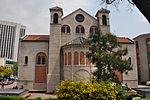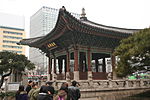Chohong Museum of Finance
Museums established in 1997Museums in SeoulNumismatic museums in AsiaSouth Korean museum stubs
The Chohong Museum of Finance is a numismatics museum in Seoul, South Korea. It was created in 1997 by the Chohung Bank, which called itself the oldest bank in Korea. The museum's collections were acquired by Shinhan Bank, which renamed the museum the Korea Financial History Museum. "The Museum of Korean Financial History collects, preserves and exhibits historic materials of Shinhan. Bank and, on a broader level, Korean financial ..."
Excerpt from the Wikipedia article Chohong Museum of Finance (License: CC BY-SA 3.0, Authors).Chohong Museum of Finance
Sejong-daero, Seoul Myeong-dong
Geographical coordinates (GPS) Address Nearby Places Show on map
Geographical coordinates (GPS)
| Latitude | Longitude |
|---|---|
| N 37.56858 ° | E 126.97642 ° |
Address
광화문연치과
Sejong-daero
04520 Seoul, Myeong-dong
South Korea
Open on Google Maps








